I’ve tracked India’s defence programmes for years, but the HAL CATS Warrior has truly captured my imagination. This isn’t just another drone; it’s India’s boldest leap into autonomous air combat. Designed by Hindustan Aeronautics Limited (HAL), the Warrior is a stealth-enabled UCAV built to fly alongside manned fighter jets.
Part of the broader Combat Air Teaming System (CATS), the Warrior is designed to fight smart, support pilots, and take on high-risk missions with autonomy.
Many ask, what powers it, how fast is it, and what’s the cost? I’ve got all the answers, plus the latest: Tata Elxsi is now building precision jigs for its prototype assembly, pushing it closer to flight trials.
If you’re curious like I was, keep reading — this is India’s future in air dominance.
What is a Loyal Wingman?
When people ask me what a “loyal wingman” really means in modern warfare, I always explain it like this: imagine a combat drone that is not just following orders but thinking alongside the pilot. It flies in formation, executes dangerous missions like electronic warfare, reconnaissance, or precision strikes, all while keeping the human pilot safer. That is the true essence of a loyal wingman: being semi-autonomous, intelligent, and battle-ready.
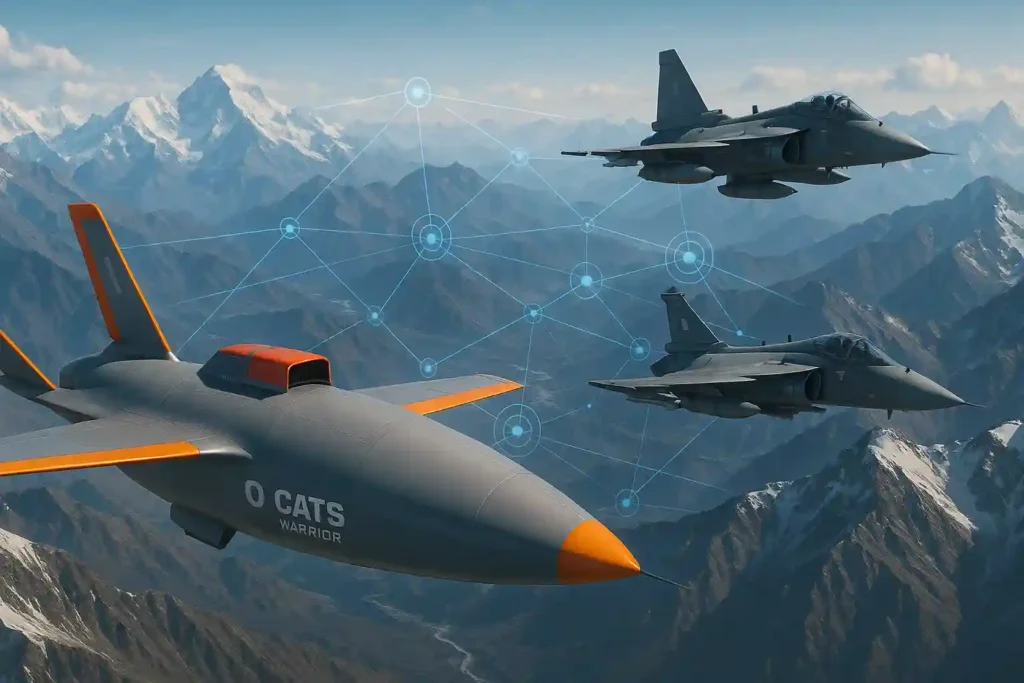
Having studied the HAL CATS Warrior in detail, I can confidently say it embodies this concept perfectly. This is not just a support drone; it is a digital teammate, designed to fly with India’s top combat aircraft like the LCA Tejas, AMCA, Su-30MKI, and the Jaguar. The Warrior does more than just tag along. It extends the pilot’s eyes, reach, and strike capability deep into contested airspace where human pilots may hesitate to venture.
From my perspective, the Warrior is a strategic force multiplier in India’s journey towards manned-unmanned teaming (MUM-T). It is not just about building advanced drones. It is about redefining air combat by merging AI, stealth, and human-machine synergy into a single, formidable platform.
HAL CATS Warrior Latest Update (2025)
I have been closely tracking the HAL CATS Warrior programme, and I can tell you that 2025 has been a landmark year for this ambitious project. In January 2025, HAL completed the engine ground run of the full-scale Warrior prototype, a critical milestone confirming that the UCAV’s propulsion system is ready for flight.
When I saw the Warrior on display at Aero India 2025, it was clear that this was not just a showpiece. The prototype was presented in its most advanced configuration yet, a strong signal that India is serious about establishing itself in the autonomous combat drone space.
As of July 15, 2025, Tata Elxsi has begun delivering precision fuselage assembly jigs, reinforcing the Warrior’s transition from prototype to production-standard platform.
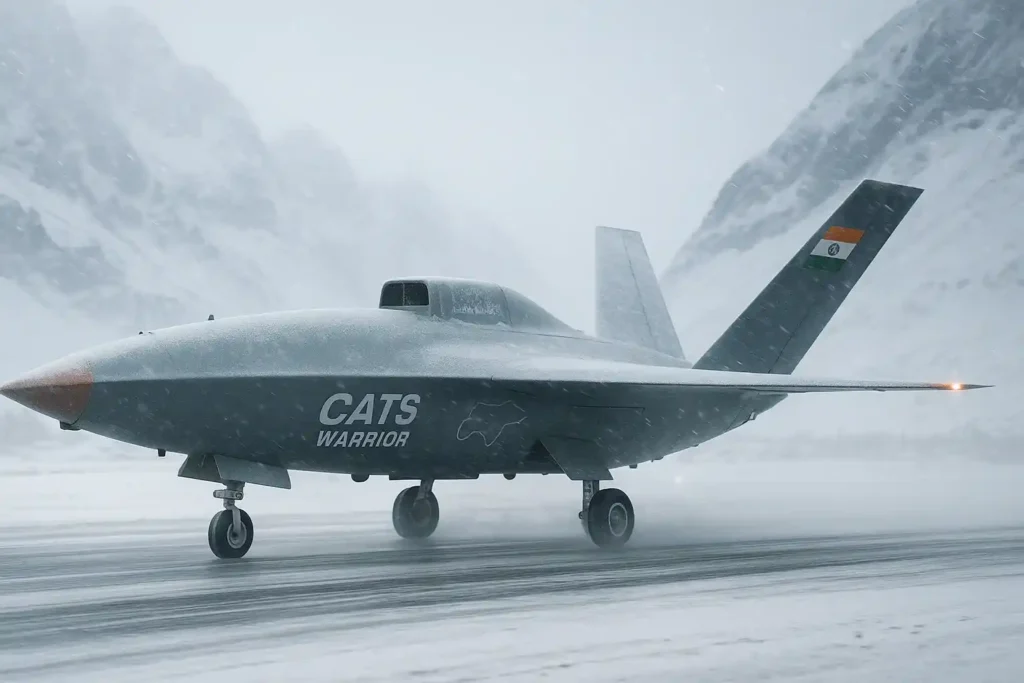
Here is what I have gathered so far:
- Taxi trials are actively underway in Bengaluru, with rigorous testing of ground handling and onboard systems.
- The first flight is expected by late 2025, although some internal sources suggest early 2026 is more realistic to ensure full readiness.
- Engineers have introduced a newly designed air intake and a stealth-optimised surface coating, both critical for reducing radar visibility.
- The programme is driven by a public-private collaboration, with NewSpace Research and Technologies contributing significantly to AI and autonomy.
Seeing the prototype up close reaffirmed for me that HAL is not just experimenting but is determined to modernise India’s aerial combat capabilities with indigenous technology. The Warrior represents more than a drone; it is a strategic leap towards manned-unmanned teaming (MUM-T) for the Indian Air Force.
If you are as fascinated by this development as I am, stay tuned. I will continue to share exclusive insights, trial updates, and what to expect when the Warrior finally takes to the skies.
Design and Stealth Architecture
I have closely studied the design of the HAL CATS Warrior, and every feature reflects a focus on stealth, survivability, and precision:
- The Warrior uses a composite airframe, giving it a low radar cross-section that makes it harder for enemy radars to detect.
- A serpentine air intake is mounted on top of the fuselage, cleverly concealing the engine’s reflective surfaces from ground-based radar systems.
- The Chevron exhaust nozzles are specifically designed to suppress heat signatures and jet emissions, reducing vulnerability to infrared tracking.
- It is coated with Radar Absorbent Material (RAM), capable of achieving over 99 percent radar attenuation, a level of stealth typically reserved for elite fighter jets.
- The overall stealth-optimised geometry ensures that every surface and angle is shaped to deflect radar waves away from the source.
- While the design shares some similarities with Australia’s MQ-28 Ghost Bat and the American XQ-58 Valkyrie, I can say with confidence that the HAL CATS Warrior is uniquely Indian, purpose-built to meet the Indian Air Force’s specific strategic requirements.
In my opinion, this is not just a drone built to fly missions. It is a carefully engineered system designed to penetrate enemy defences, strike effectively, and return undetected — a true force multiplier for India’s air power.
HAL CATS Warrior Engine Types & Propulsion
From my research into its propulsion system, I can confirm that the HAL CATS Warrior is powered by two indigenous PTAE-W turbojet engines. These are evolved versions of HAL’s PTAE-7 engine, which was originally designed for the DRDO Lakshya drone.
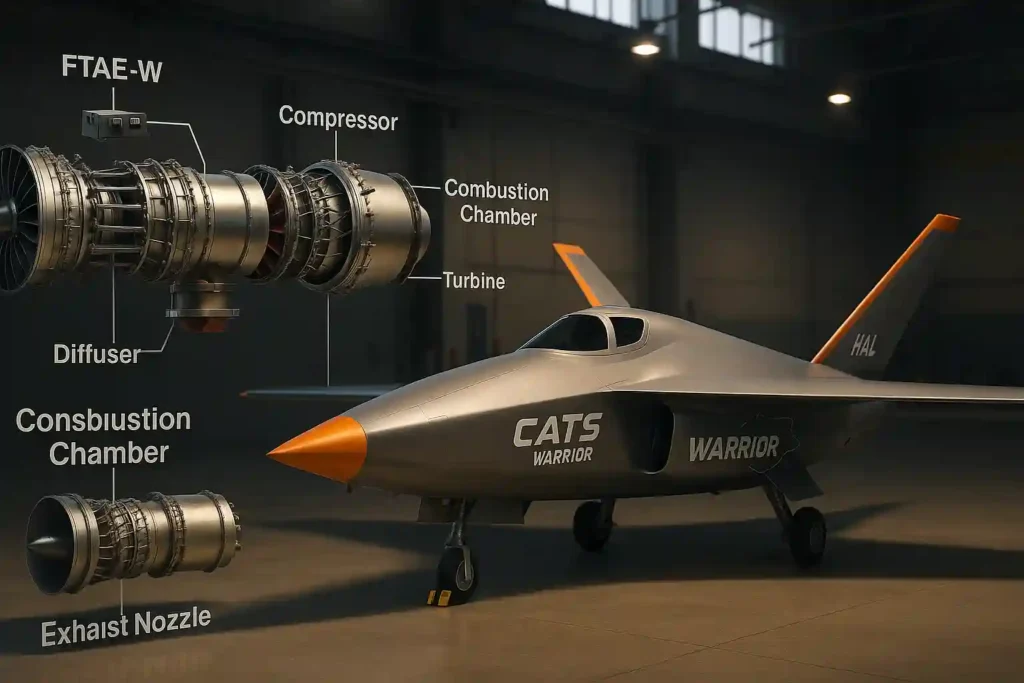
Here are the key engine specifications I have gathered:
- Each engine produces a thrust of 3.7 kN, providing the Warrior with sufficient power for high-agility missions.
- The dry weight of each engine is 65 kilograms, keeping the aircraft lightweight and manoeuvrable.
- A FADEC (Full Authority Digital Engine Control) system is integrated, allowing precise and automated engine control for enhanced performance.
- The engines offer a Time Between Overhaul (TBO) of 1,000 hours, ensuring durability and operational reliability.
In my view, these engines strike the perfect balance between compact design, fuel efficiency, and tactical agility, making the CATS Warrior not just fast but smartly optimised for endurance and performance.
HAL CATS Warrior Maximum Speed & Flight Capability
One of the questions I often come across about the HAL CATS Warrior is regarding its maximum speed. Let me clarify, while the Warrior is not supersonic, it is purpose-built for endurance and stealth, not sheer speed.
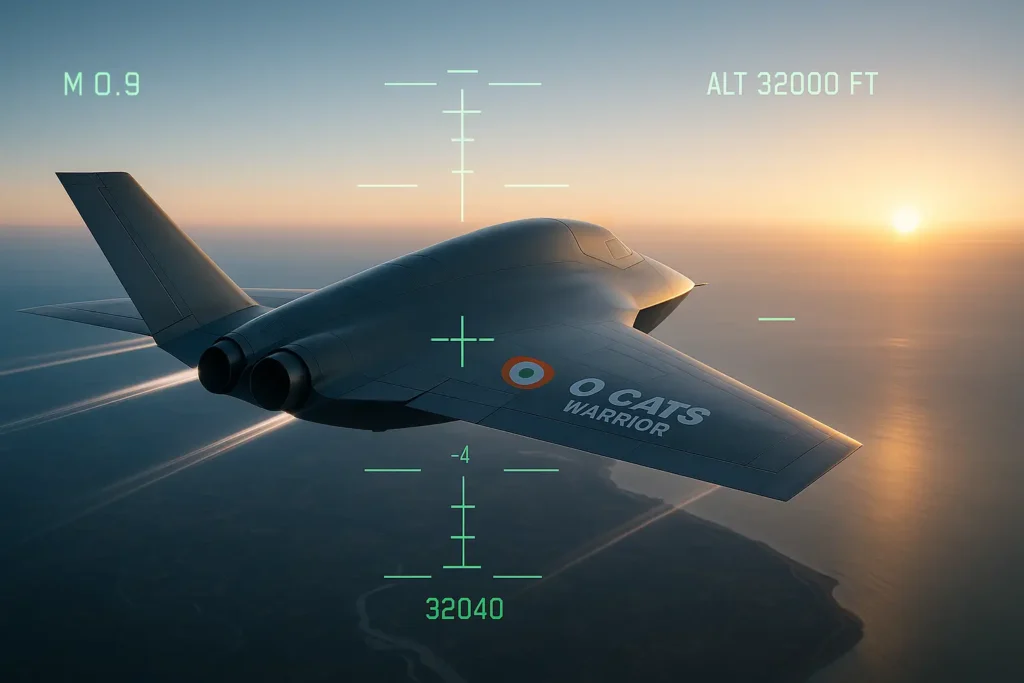
Based on my insights, here is the performance profile of the CATS Warrior:
- The maximum speed is Mach 0.9, which is just under the speed of sound but fast enough for tactical operations.
- It typically cruises at around 790 km/h, approximately Mach 0.6, which is optimal for conserving fuel and maintaining stealth.
- The Warrior can reach a service ceiling of 9,000 metres, or 30,000 feet, enabling it to operate above most threat envelopes.
- In terms of range, its combat radius for a return mission is 350 kilometres, ensuring it can engage and return safely.
- For a one-way or sacrificial strike mission, it can reach up to 800 kilometres, extending its operational reach deep into hostile territory.
In my analysis, this balance of speed, range, altitude, and stealth makes the Warrior perfectly suited for long-endurance, high-risk missions, where avoiding interception is just as critical as the strike itself.
Weapons, Payload, and Combat Roles
From what I have gathered about the HAL CATS Warrior, it is equipped to handle a wide range of strategic combat roles. Whether it is suppressing enemy air defences, performing decoy operations, or conducting precision air-to-ground strikes, the Warrior is designed to deliver on multiple fronts.
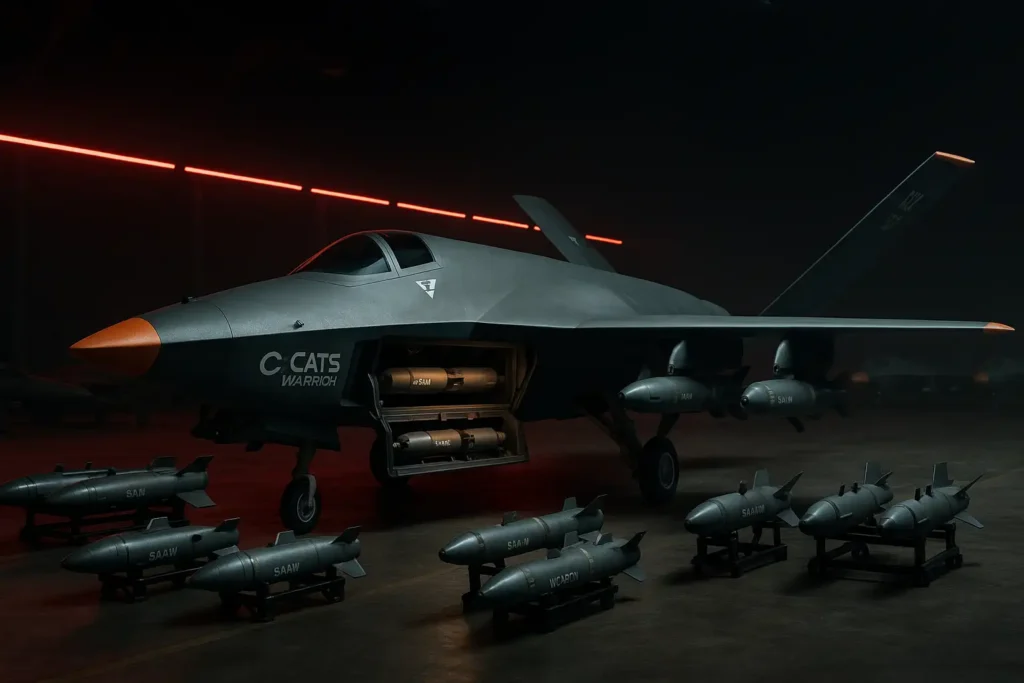
Here is a breakdown of its armament and payload capacity:
- The internal weapons bay can carry two DRDO Smart Anti-Airfield Weapons (SAAW), allowing the Warrior to strike high-value ground targets while maintaining stealth.
- On the external pylons, it can be armed with two New-Generation Close Combat Missiles (NG-CCM) or the ASRAAM, providing it with air-to-air engagement capabilities.
- The total payload capacity stands at 650 kilograms, which is substantial for a UCAV of its class.
In my view, the internal bay is a smart feature because it helps the Warrior stay stealthy during offensive missions. However, when flexibility is needed, the external hardpoints allow it to carry additional munitions, adapting to different mission requirements without compromising its tactical advantage.
Advanced Avionics and AI Integration
What truly sets the HAL CATS Warrior apart, in my assessment, is that it is more than just a combat drone. It is equipped with a comprehensive suite of AI-powered avionics and surveillance systems, making it highly capable even in contested environments.
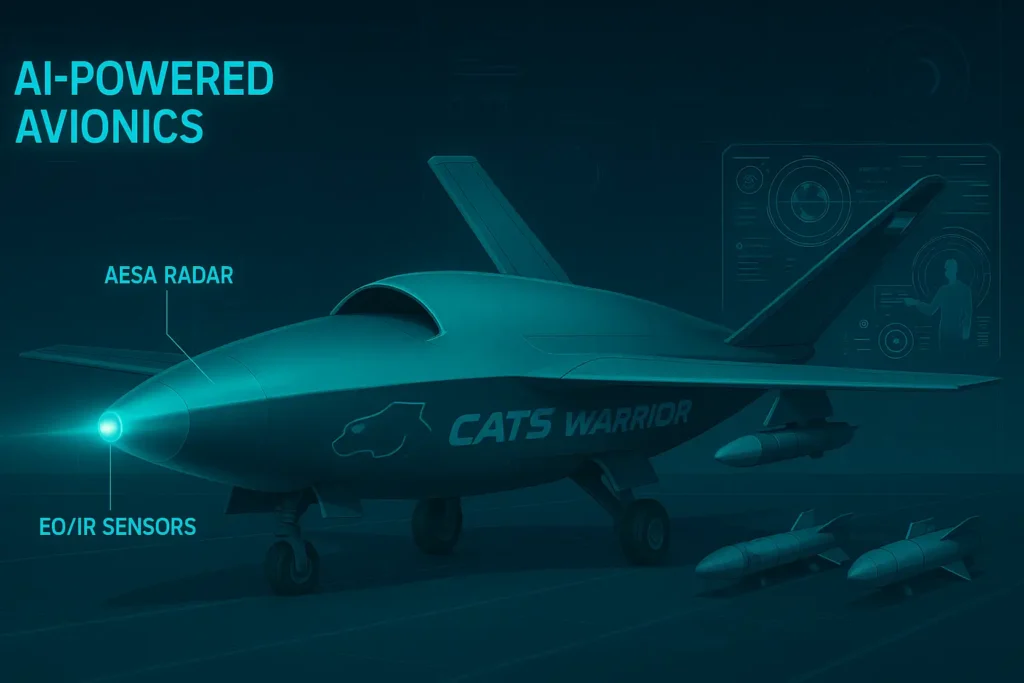
Here are the key avionics features I have noted:
- An indigenous mission computer, developed by SLRDC, forms the brain of the system, enabling advanced mission processing.
- An AESA radar provides multi-target tracking, crucial for situational awareness and threat engagement.
- The Warrior carries Electro-Optic/Infrared (EO/IR) payloads, allowing for effective surveillance and targeting in both day and night conditions.
- An integrated electronic jammer is onboard to disrupt enemy communications and radar systems.
- The system is guided by an Inertial Navigation System (INS), ensuring precise navigation even in GPS-denied environments.
Thanks to these technologies, combined with its AI-driven autonomy, the Warrior can operate with minimal human intervention, yet it remains firmly connected to its mothership fighter jet for coordinated missions. This synergy between human pilots and autonomous systems is what makes the Warrior a key player in the future of air combat.
How Much Does the CATS Warrior Cost?
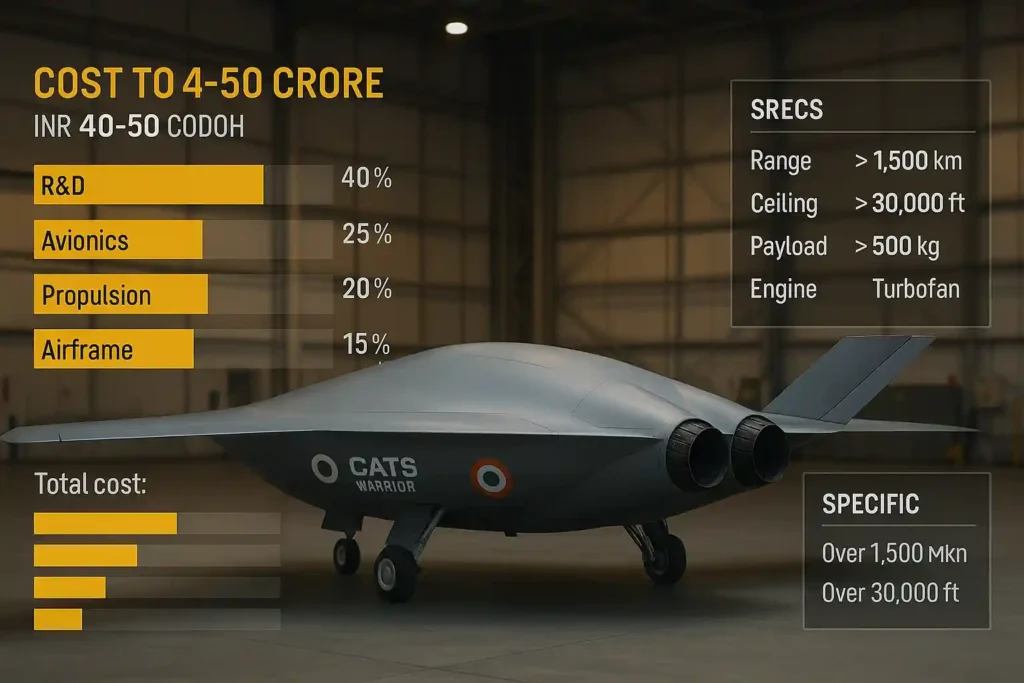
While the exact price has not been officially disclosed, estimates place the cost of one HAL CATS Warrior unit at INR 40–50 crore (approximately USD 5–6 million), as suggested by defence analysts covering Aero India 2025.
This is relatively affordable considering its combat versatility and low-observable tech. Compared to manned fighters, the Warrior offers cost-effective mission extension without putting pilots at risk.
Strategic Importance & Role in Indian Defence
From what I have observed, India’s air doctrine is undergoing a significant transformation, and the HAL CATS Warrior is at the heart of this evolution. The Indian Air Force is preparing for a future where manned-unmanned teaming (MUM-T) will play a dominant role in shaping air operations.

Here is why the CATS Warrior matters so much:
- It acts as a force multiplier, significantly expanding the combat effectiveness of each manned fighter it operates with.
- It helps in reducing pilot risk by taking on the most dangerous frontline tasks, where sending a manned aircraft might be too costly.
- It enhances situational awareness by providing the mothership fighter with real-time sensor data from contested zones.
- Being built with indigenous technology, it reduces India’s dependency on imports, strengthening the country’s defence self-reliance.
For a broader perspective on how India is shaping its future airpower, I highly recommend exploring our in-depth features on the AMCA Development Timeline, the TEDBF Naval Jet, and the Ghatak UCAV Programme.
What to Expect in the Future
Based on everything I have tracked so far, the future looks promising for the HAL CATS Warrior. The progress has been steady, and here is what we can expect in the coming months:
- Taxi trials are currently underway as of mid-2025, with engineers fine-tuning the systems for the next phase.
- The first flight is projected by the end of 2025, although some sources suggest it may realistically occur by early 2026 to ensure complete mission readiness.
- We can expect phased integration with the Indian Air Force and Navy starting from 2026, which will mark a significant step in India’s adoption of manned-unmanned teaming.
From my perspective, if the Warrior’s flight tests meet expectations, it could pave the way for smaller, specialised variants tailored for naval aviation, including carrier-based operations and swarm missions. This is just the beginning of India’s journey into next-generation air combat, and the Warrior is poised to be the flagship of that transformation.
Final Thoughts
In my view, the HAL CATS Warrior is far more than just a drone. It is India’s declaration that we are ready for the future of warfare. With its combination of stealth technology, AI-driven systems, indigenous engines, and multi-role flexibility, the Warrior is shaping up to be a cornerstone of modern air combat.
What makes this journey even more significant is the involvement of the private sector. Tata Elxsi is playing a crucial role by developing precision fuselage assembly jigs, ensuring the prototypes are built with aerospace-grade accuracy. Their expertise is fast-tracking the Warrior’s path from prototype to a flight-ready combat asset.
Having studied its design and capabilities, I can confidently say that from engine performance and speed to its strategic cost advantage, the CATS Warrior ticks every box for what a successful unmanned aerial combat system should be.
Want more updates on HAL’s autonomous systems and UCAV projects? Subscribe to our DefenceTech newsletter or follow us on [DefenceNewsIndia.in] for exclusive deep-dives and expert analysis.
